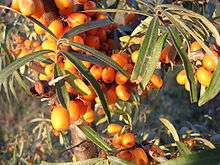Sea buckthorn oil

Sea buckthorn oil is derived from plants in a group of species of the genus Hippophae, the most commonly used of which is Hippophae rhamnoides. As species belonging to this genus accumulate lipids in the mesocarp (the fleshy part of the fruit),[1] oil can be extracted from either the seeds or the pulp of the fruit.
Chemical constituents
Oil content in seeds of sea buckthorn is on average 7-11 % while oil content of pulp is around 1.5-3 % (per fresh weight).[1] Seed oil is characterized with high contents of polyunsaturated fatty acids[1] while pulp oil contains monounsaturated fatty acids[1] and carotenoids.[2] Both oils also contain dense amounts of tocopherols, tocotrienols [3] and plant sterols.[4]
Fatty acids
Oils from sea buckthorn seeds and pulp differ considerably in fatty acid composition. While linoleic acid and α-linolenic acid are the major fatty acids in seed oil, sea buckthorn pulp oil contains approximately 65% combined of the monounsaturated fatty acid, palmitoleic acid, and the saturated fatty acid, palmitic acid.[1] Few other vegetable oils contain a similar quantity of these fatty acids.
Tocopherols and tocotrienols
α-Tocopherol is the major vitamin E compound in sea buckthorn. Seed oil also contains considerable amounts of gamma-tocopherol. The total amount of tocopherols and tocotrienols in seed oil is roughly 100–300 mg/100 g and in pulp oil 100–200 mg/100 g of oil.[3]
Carotenoids
As carotenoids are the pigments that give sea buckthorn berry its distinctive colour, these compounds are present in high amounts in pulp oil. However, the total content of carotenoids varies (300–2000 mg/100 g) greatly between different growth locations and subspecies.[5] In general, the main carotenoids present in pulp oil are beta-carotene, zeaxanthin and lycopene.[2]
Plant sterols
Both seed and pulp oil also contain considerable amounts of plant sterols (12-23 g/kg and 10-29 g/kg of oil, respectively). Beta-sitosterol is the major sterol compound throughout the berry which constitutes 57-83% of total sterols.[4]
Medical research
Laboratory work suggests that sea buckthorn oil has anticarcinogenic properties, though there is no evidence of whether this translates into any effect of human health.[6]
References
- 1 2 3 4 5 Yang, Baoru; Kallio, Heikki P. (April 2001). "Fatty acid composition of lipids in sea buckthorn (Hippophaë rhamnoides L.) berries of different origins". Journal of Agricultural and Food Chemistry. 49 (4): 1939–1947. doi:10.1021/jf001059s. ISSN 0021-8561. Retrieved 2015-06-10.
- 1 2 Andersson, Staffan C.; Olsson, Marie E.; Johansson, Eva; Rumpunen, Kimmo (2009). "Carotenoids in sea buckthorn (Hippophae rhamnoides L.) berries during ripening and use of pheophytin a as a maturity marker". Journal of Agricultural and Food Chemistry. 57 (1): 250–258. doi:10.1021/jf802599f. ISSN 0021-8561. Retrieved 2015-06-01.
- 1 2 Kallio, Heikki; Yang, Baoru; Peippo, Pekka; Tahvonen, Raija; Pan, Ruilin (April 2002). "Triacylglycerols, glycerophospholipids, tocopherols, and tocotrienols in berries and seeds of two subspecies (ssp. sinensis and mongolica) of sea buckthorn (Hippophaë rhamnoides)". Journal of Agricultural and Food Chemistry. 50 (10): 3004–3009. doi:10.1021/jf011556o. ISSN 0021-8561. Retrieved 2015-06-10.
- 1 2 Yang, Baoru; Karlsson, Riina M.; Oksman, Pentti H.; Kallio, Heikki P. (March 2001). "Phytosterols in sea buckthorn (Hippophaë rhamnoides L.) berries: identification and effects of different origins and harvesting times". Journal of Agricultural and Food Chemistry. 49 (11): 5620–5629. doi:10.1021/jf010813m. ISSN 0021-8561. Retrieved 2015-06-10.
- ↑ Bal, Lalit M.; Meda, Venkatesh; Naik, S. N.; Satya, Santosh (2011). "Sea buckthorn berries: a potential source of valuable nutrients for nutraceuticals and cosmoceuticals". Food Research International. Exotic Fruits: their Composition, Nutraceutical and Agroindustrial Potential. 44 (7): 1718–1727. doi:10.1016/j.foodres.2011.03.002. ISSN 0963-9969. Retrieved 2015-06-02.
- ↑ Zeb A (2006). "Anticarcinogenic potential of lipids from Hippophae--evidence from the recent literature". Asian Pac. J. Cancer Prev. (Review). 7 (1): 32–5. PMID 16629511.